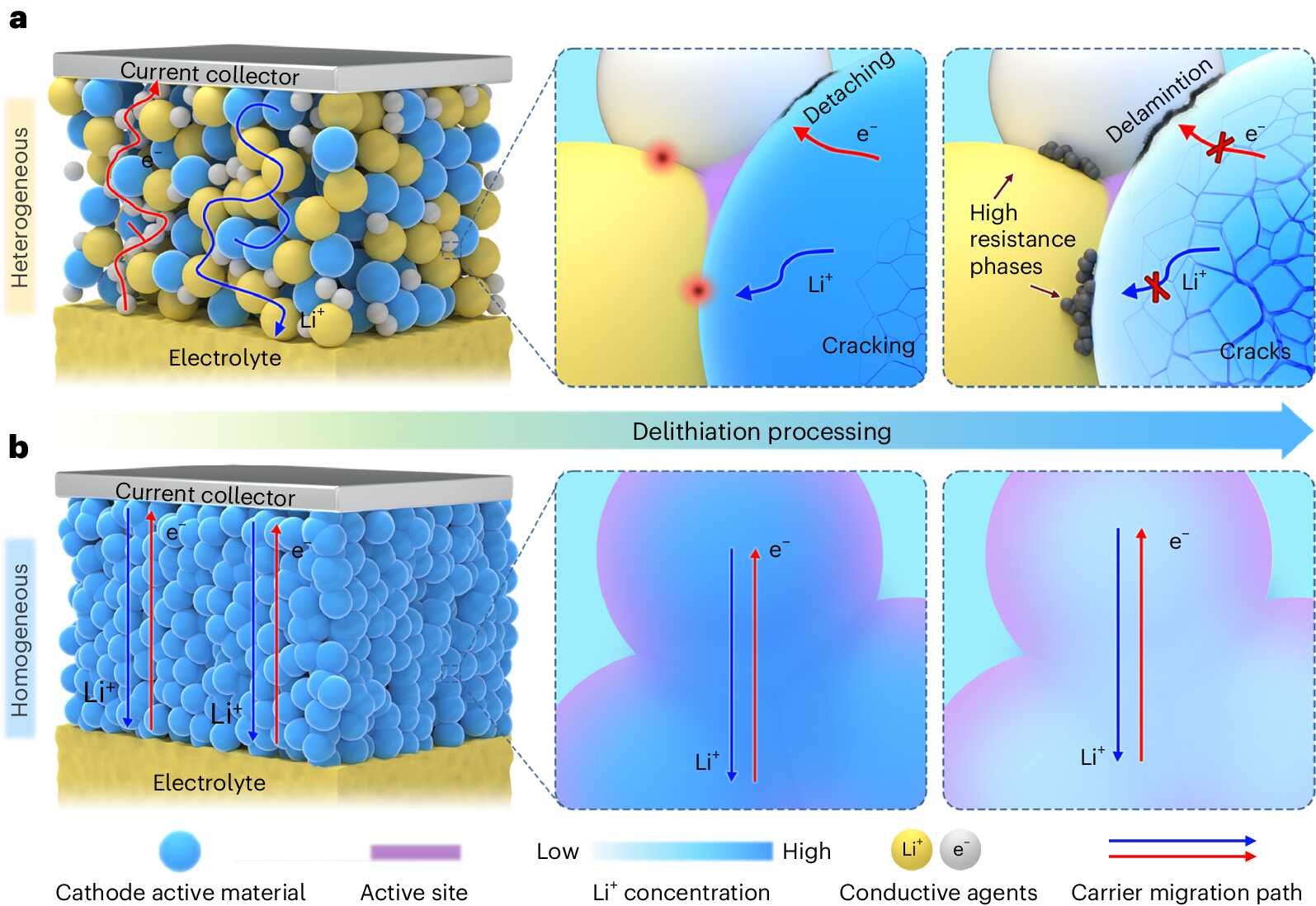Researchers from the Chinese Academy of Sciences Qingdao Institute of Bioenergy and Bioprocess Technology have unveiled a novel cathode homogenization approach for All-Solid-State Lithium Batteries (ASLBs). This novel strategy greatly increased the cycle life and energy density of ASLBs and marked a significant breakthrough in energy storage technology. The journal Nature Energy published this study.
 Schematic illustration of cathode microstructure evolution during charging. (a) Conventional heterogeneous composite cathode and (b) the proposed homogeneous cathode with efficient mixed conduction. Image Credit: Qingdao Institute of Bioenergy and Bioprocess Technology
Schematic illustration of cathode microstructure evolution during charging. (a) Conventional heterogeneous composite cathode and (b) the proposed homogeneous cathode with efficient mixed conduction. Image Credit: Qingdao Institute of Bioenergy and Bioprocess Technology
Heterogeneous composite cathodes, which need electrochemically inactive additives to improve conduction, present a difficulty for current ASLBs. Although essential, these additions shorten the batteries' cycle life and energy density because they are incompatible with the layered oxide cathodes, which experience significant volume changes while operating.
An approach to cathode homogenization using Li1.75 Ti2(Ge0.25 P0.75S3.8Se0.2)3 (LTG0.25PSSe0.2), a zero-strain material, has been devised by researchers as a solution. Without further conductive additives, this material's outstanding combined ionic and electronic conductivity ensures effective charge transport throughout the (dis)charge process.
Impressive performance parameters are displayed by the LTG0.25PSSe0.2 material, which includes a specific capacity of 250 mAh g–1 and a low volume change of only 1.2%. Room-temperature ASLBs may reach over 20,000 cycles of reliable operation and a high energy density of 390 Wh kg−1 at the cell level, thanks to a homogenous cathode composed solely of LTG0.25PSSe0.2.
Our cathode homogenization strategy challenges the conventional heterogeneous cathode design. By eliminating the need for inactive additives, we enhance energy density and extend the battery's cycle life.
Dr. Longfei Cui, Study Co-First Author, Solid Energy System Technology Center, Qingdao Institute of Bioenergy and Bioprocess Technology
Dr. Shu Zhang, Co-First Author of the SERGY study, adds, “This approach is a game-changer for ASLBs. The combination of high energy density and extended cycle life opens up new possibilities for the future of energy storage.”
“The material's stability and performance metrics are impressive, making it a strong candidate for commercial applications in electric vehicles and large-scale energy storage systems.
Jiang Wei Ju, Professor and Study Co-Corresponding Author, Solid Energy System Technology Center, Qingdao Institute of Bioenergy and Technology Bioprocess
Theoretical calculations and thorough testing justify this advancement. These analyses verify the homogeneous cathodes' mechanical and electrochemical stability, demonstrating no unfavorable chemical reactions or appreciable resistance increases following extended cycling.
In addition to ASLBs, heterogeneous electrodes are a problem for solid-state sodium batteries, lithium-ion batteries, lithium-sulfur batteries, sodium-ion batteries, and fuel cells. Mechanochemical and electrochemical incompatibilities plague these systems frequently, leading to major bottlenecks and a reduction in battery performance overall.
The commercialization potential for high-energy-density ASLBs is now more achievable. Our universal strategy for designing multifunctional homogeneous cathodes can overcome the energy, power, and lifespan barriers in energy storage, paving the way for real-world applications.
Guanglei Cui, Professor and Head, Solid Energy System Technology Center, Qingdao Institute of Bioenergy and Technology Bioprocess
By tackling major obstacles in ASLBs, this approach lays the groundwork for the next advancements in energy storage technology. The group intends to investigate the LTG0.25PSSe0.2 material's scalability and potential integration into useful battery systems in further detail.
This effort marks an important turning point in battery technology and provides hope for further developments. It is anticipated that the team's creative methodology will impact upcoming energy storage research and development, laying a solid foundation for the following generation of high-performance batteries.
Journal Reference:
Cui, L., et al. (2024) A cathode homogenization strategy for enabling long-cycle-life all-solid-state lithium batteries. Nature Energy. doi.org/10.1038/s41560-024-01596-6.